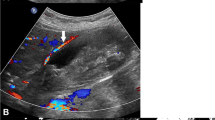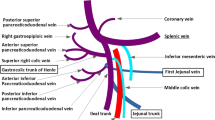Abstract
Transcatheter arterial embolization (TAE) is accepted to be an effective treatment in both resectable and nonresectable hepatoma, which is very prevalent in Taiwan. Two hundred and twenty-five embolizations of TAE were performed in 137 patients in a 3-year period. Postembolization syndrome developed in the majority of patients. We analyzed these patients to study the nature and incidence of unusual complications and the surgical role in their managment. In our series, unusual complications, which were rarely reported in the literature, included 13 cases (5.8%) of gastroduodenal bleeding, 2 cases (0.9%) of duodenal perforation, 9 cases (4.0%) of acute pancreatitis with 1 case of gangrenous change, 24 cases (10.7%) of gallbladder infarction with 1 case of perforation, 4 cases (1.8%) of delayed formation of gallstones, 3 cases (1.3%) of hyperuricemia, and 2 cases (0.9%) of hepatoma rupture. Ischemic necrosis of the organs may be attributed to the inadvertent blockade of the gastroduodenal artery, gastric artery, cystic artery, and important collaterals. Inadequate superselectivity, the size of the tumor, regurgitation of embolus, anatomical variations, injury of vessel intima, or pseudoaneurysm formation resulting from previous embolization attempts made the avoidance of complications difficult with this technique. Most of the unusual complications could be managed by conservative treatment, but urgent operation was indicated in the cases of organ perforation. Elective operation was also needed for the delayed formation of gallstones with prominent symptoms. Awareness of the occurrence of these untoward sequelae makes us more careful in the evaluation and long-term follow-up of patients following TAE. Surgical intervention plays a selective but important role in the management of these unusual complications.
Résumé
L'embolisation par cathétérisme artériel occupe à Taiwan une place fiable dans le traitement de l'hépatome opérable ou de l'hépatome inopérable. Au cours d'une période de 3 ans 225 embolisations intra-artérielle ont été pratiquées chez 137 malades. Dans la majorité des cas l'embolisation a entrainé des phénomènes secondaires anormaux. Les auteurs font état de complications inhabituelles qui ont été rarement relatées dans la littérature: 13 cas (5.8%) d'hémorragie gastro-duodénale, 2 cas (0.9%) de perforation duodénale, 9 cas (4.0%) de pancréatite aigue dont une avec altérations gangréneuses, 24 cas (10.7%) d'infarcissement de la vésicule dont un avec perforation, 4 cas (1.8%) de formation retardée de calculs vésiculaires, 3 cas (1.3%) d'hyperuricémie, 2 cas (0.9%) de rupture de l'hématome. La nécrose ischémique des organes peut être attribuée à l'obstruction imprévue de l'artère gastro-duodénale, de l'artère gastrique, de l'artère cystique, et d'importantes collatérales. De multiples facteurs peuvent être invoqués pour expliquer les complications indésirables de l'embolisation: cathétérisme hypersélectif inadéquat, volume de la tumeur, régurgitation de l'embolus, blessure de l'intima artérielle, formation pseudoanévrysmale résultant de tentatives antérieures de cathétérisme artériel. La majorité d'entre elles peuvent être traitées médicalement mais l'intervention d'urgence s'impose quand une perforation viscérale est en cause. Il convient également de procéder à la cholécystectomie lorsque la lithiase vésiculaire entraîne des troubles importants. Connaître l'existence possible de ces accidents fâcheux doit rendre circonspect dans l'évaluation exacte de la valeur et le suivi à long terme de l'embolisation. De toute façon l'intervention chirurgicale est indispensable pour traiter certaines complications de l'embolisation.
Resumen
La embolización arterial por cateterismo (EAC) es aceptada como tratamiento efectivo tanto en los hepatomas resecables como en los no resecables, tumores de alta incidencia en Taiwan. Doscientos veinticinco embolizaciones por EAC fueron realizadas en 137 pacientes en un período de 3 años; el síndrome de postembolización se desarrolló en la mayoría de los pacientes. Hemos analizado estos pacientes para estudiar la naturaleza y la incidencia de las complicaciones poco usuales y el papel de la cirugía en su manejo. Las complicaciones poco usuales observadas en nuestra serie, las cuales son raramente informadas en la literatura, incluyen 13 casos (5.8%) de hemorragia gastroduodenal, 2 casos (0.9%) de perforación duodenal, 9 casos (4.0%) de pancreatitis aguda con 1 caso de necrosis gangrenosa, 24 casos (10.7%) de infarto de la vesícula biliar con 1 caso de perforación, 4 casos (1.8%) de formación tardía de cálculos, 3 casos (1.3%) de hiperuricemia, y 2 casos (0.9%) de ruptura del hepatoma. La necrosis isquémica de los órganos puede ser atribuida a la oclusión inadvertida de la arteria gastroduodenal, la arteria gástrica, la arteria cística, y colaterales importantes. Superselectividad inadecuada, tamaño del tumor, regurgitación del émbolo, variaciones anatómicas, lesión de la íntima de la pared vascular, o formación de pseudoaneurismas como consecuencia de intentos previos de embolización hicieron difícil evitar las complicaciones con esta técnica. La mayoría de estas complicaciones poco usuales pudieron ser manejadas con tratamiento conservador, pero la operación de urgencia fue necesaria en casos de perforación de un órgano. La operación electiva también fue necesaria en los casos con formación tardía de cálculos biliares y síntomas prominentes. La toma de conciencia sobre la posibilidad de este tipo de secuelas nos ha hecho aún más cuidadosos en la evaluación y el seguimiento a largo plazo de los pacientes sometidos a EAC. La intervención quirúrgica juega un papel selectivo pero importante en el manejo de estas complicaciones poco usuales.
Similar content being viewed by others
References
Department of Health, the Executive Yuan, Republic of China: Cancer Registry Annual Report in Taiwan Area, March, 1985, pp. 12–13
Wheeler, P.G., Melia, W., Dubbins, P., Jones, B., Nunnerley, H., Johnson, P., Williams, R.: Non-operative arterial embolization in primary liver tumors. Br. Med. J.2:242, 1979
Yamada, R., Sato, M., Kawabata, M., Nakatsuka, H., Nakamura, K., Takashima, S.: Hepatic artery embolization in 120 patients with unresectable hepatoma. Radiology148:397, 1983
Chuang, V.P., Wallace, S.: Hepatic artery embolization in the treatment of hepatic neoplasms. Radiology140:51, 1981
Chuang, V.P., Wallace, S., Soo, C.S., Charnsangavej, C., Bowers, T.: Therapeutic Ivalon embolization of hepatic tumors. A.J.R.138:289, 1982
Kuroda, C., Iwasaki, M., Tanaka, T., Tokunaga, K., Hori, S., Yoshioka, H., Sakurai, M., Okamura, J.: Gallbladder infarction following hepatic transcatheter arterial embolization. Radiology149:85, 1983
Chuang, V.P.: Hepatic tumor angiography: A subject review. Radiology148:633, 1983
Takayasu, K., Moriyama, N., Muramatsu, Y., Suzuki, M., Ishikawa, T., Ushio, K., Matsue, H., Sasagawa, M., Yamada, T.: Splenic infarction, a complication of transcatheter hepatic arterial embolization for liver malignancies. Radiology151:371, 1984
Sukurai, M., Okamura, J., Kuroda, C.: Transcatheter chemoembolization effective for treating hepatocellular carcinoma. A histopathologic study. Cancer54:387, 1984
Okamura, J., Horikawa, S., Fujiyama, T., Monden, M., Kambayashi, J., Sikujara, O., Kosaki, G., Sakurai, M., Kuroda, C., Nakamura, H.: An appraisal of transcatheter arterial embolization combined with transcatheter arterial infusion of chemotherapeutic agent for hepatic malignancies. World J. Surg.6:352, 1982
Bernardino, M.E., Chuang, V.P., Wallace, S., Thomas, J.L., Soo, C.S.: Therapeutically infarcted tumors: CT findings. A.J.R.136:527, 1981
Trojanowski, J.Q., Harrist, T.J., Athanasoulis, C.A., Greenfield, A.J.: Hepatic and splenic infarctions: Complications of therapeutic transcatheter embolization. Am. J. Surg.139:272, 1980
Chuang, V.P., Wallace, S., Stroehlein, J., Yap, H.Y., Patt, Y.Z.: Hepatic artery infusion chemotherapy: Gastroduodenal complications. A.J.R.137:347, 1981
De Jode, L.R., Nicholls, R.J., Wright, P.L.: Ischemic necrosis of the gallbladder following hepatic artery embolism. Br. J. Surg.63:621, 1976
Doppman, J.L., Girton, M., Vermess, M.: The risk of hepatic artery embolization in the presence of obstructive jaundice. Radiology143:37, 1982
Doppman, J.L., Dunnick, R.N., Girton, M., Franci, A.S., Popovsky, M.A.: Bile duct cysts secondary to liver infarcts: Report of a case and experimental production by small vessel hepatic artery occlusion. Radiology130:1, 1979
Soo, C.S., Chuang, V.P., Wallace, S., Charnsangavej, C., Carrasco, H.: Treatment of hepatic neoplasm through extrahepatic collaterals. Radiology147:45, 1983
Clouse, M.E., Lee, R.G.L., Duszlak, E.J., Lokich, J.J., Trey, C., Alday, M.R., Yoburn, D.C., Diamond, J., Crosson, A.W., Ostello, P.: Peripheral hepatic artery embolization for primary and secondary hepatic neoplasms. Radiology147:407, 1983
Takayasu, K., Moriyama, N., Muramatsu, Y., Suzuki, M., Yamada, T., Kishik, K., Hasagawa, H., Okazaki, N.: Hepatic arterial embolization for hepatocellular carcinoma, comparison of CT scans and resected specimens. Radiology150:661, 1984
Chuang, V.P., Wallace, S.: Hepatic arterial redistribution for intraarterial infusion of hepatic neoplasms. Radiology135:295, 1980
Charnsangavej, C., Chuang, V.P., Wallace, S., Soo, C.S., Bowers, T.: Angiographic classification of hepatic arterial collaterals. Radiology144:485, 1982
Patt, Y.Z., Mavligit, G.M., Chuang, V.P., Wallace, S., Johnston, S., Benjamin, R.S., Valdivieso, M., Hersh, E.M.: Percutaneous hepatic arterial infusion (HAI) of mitomycin C and floxuridine (FUDR): An effective treatment for metastatic colorectal carcinoma in the liver. Cancer46:261, 1980
Onodera, H., Oikawa, M., Abe, M., Goto, Y.: Gallbladder necrosis after transcatheter arterial embolization: A technique to avoid this complication. Radiology152:209, 1984
Rueyo, I., Guzman, A., Fernandez, F., Garia-Moran, M., Medina, M.F., Faed, J., Rodrigol Jimenez, J.R.: Liver abscess complicating embolization of focal nodular hyperplasia. A.J.R.133:740, 1979
Tsang, Y.M., Au, W.Y., Chiang, P.U., Hwang, K.M., Wei, T.C., Sung, J.L.: Transcatheter arterial embolization for hepatic tumors, balloon occlusion techniques versus superselective cannulation. Chin. J. Radiol.10:47, 1985
Author information
Authors and Affiliations
Rights and permissions
About this article
Cite this article
Jeng, K.S., Ching, H.J. The role of surgery in the management of unusual complications of transcatheter arterial embolization for hepatocellular carcinoma. World J. Surg. 12, 362–367 (1988). https://doi.org/10.1007/BF01655673
Issue Date:
DOI: https://doi.org/10.1007/BF01655673




